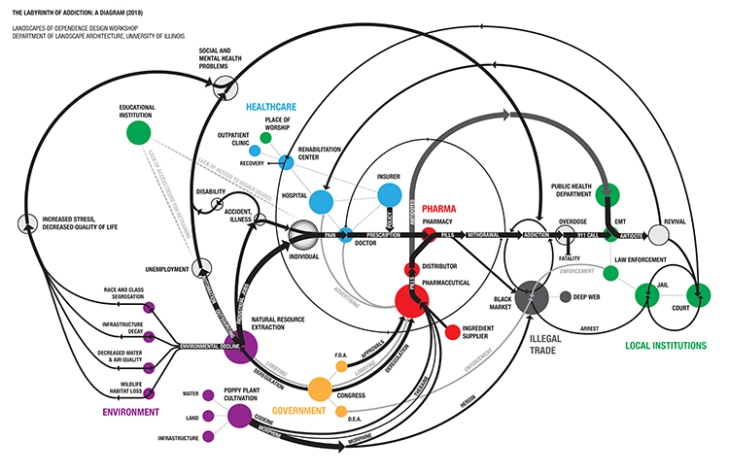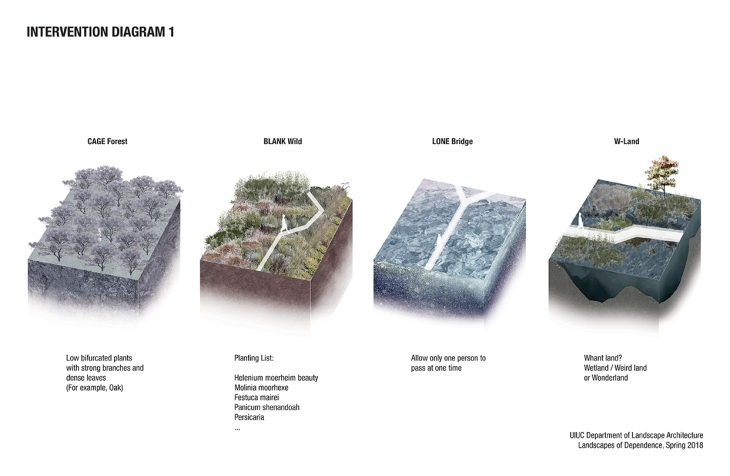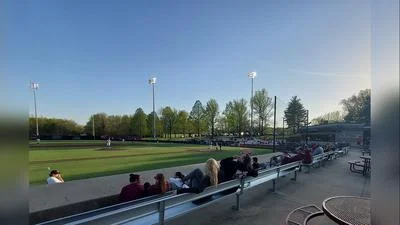Touch of Nature Environmental Center recently issued the following announcement.
For her study of the landscape dimensions of the opioid crisis, Aneesha Dharwadker, a designer in residence at the University of Illinois at Urbana-Champaign, taught an undergraduate and graduate studio grounded in the endlessly complex set of cultural, economic, and environmental factors that contribute to addiction. Called “Landscapes of Dependence,” the landscape architecture studio synthesized research into a diagram called “The Labyrinth of Addiction.”
The diagram portrays addiction not as a cycle or individual pathology, but as an intricate maze, an array of orbits connecting the pharmaceutical industry, poppy cultivation, the environmental conditions of users, health care resources, and local institutions—punitive and otherwise. As explained by the accompanying website and manifesto “The Declaration of Dependence,” there’s no single entry point to the labyrinth, no clear linear progression, and only one dead end: fatality after an overdose. Everything else is an endless feedback loop. Invited by Dharwadker onto campus for reviews in April, I was confronted by the intimidating vortex her students were tasked to defy.

“The Labyrinth of Addiction.” Image courtesy the University of Illinois at Urbana–Champaign.
But this diagram (assembled after weeks of research) allows students to intercede and disrupt these loops anywhere along the way. Their proposals, for example, offer design interventions that reorganize the cultivation of poppy plants used to make opioids, and provide new economic development opportunities for small towns reeling from the loss of manufacturing and mining jobs, in addition to landscapes with more direct paths to wellness through healing gardens and communion with nature.
The proposals are a humble vision of design’s agency to heal. The complexity of the labyrinth framework implicitly highlights the hubris any one discipline must have to think it could solve such a problem. Design alone can’t save the world, especially without fundamental grounding in and empathy for local conditions. “We can offer design visions that other people haven’t thought of, but our design visions cannot operate alone,” Dharwadker says.
Call it landscape architecture’s own “declaration of dependence.”

Minbo Zhao’s “Better Trail, Better Life.” Image courtesy the University of Illinois at Urbana–Champaign.
To close this gap, her studio had a strong multidisciplinary focus, inviting in experts from outside of design to talk with students. In an attempt to “move beyond a designer’s voyeurism,” Dharwadker says, she gathered three medical professionals, a University of Kentucky geography professor, an environmental scientist, and a documentary filmmaker to share their perspectives.
The medical professionals “notice so much about their environments, and they’re able to talk about problems with their environment for their patients,” Dharwadker says, “but we were able to offer possibilities for a different future.”
Wiley Jenkins, who holds a PhD in public health and is the science director at the Southern Illinois University School of Medicine’s Office of Population Science and Policy, is studying infectious diseases associated with injection opioid drug use, and was also on campus for reviews. He said he was impressed by how the landscape architecture students placed economic development at the heart of their plans. “People have talked about that before in a general sense of addictive behaviors, but I don’t know that the connection has been made explicitly with the current opioid epidemic, which has really only been widely known and widely talked about for a couple of years now,” he says. Jenkins gave students perspective on how difficult it can be to establish specialized treatment centers in resource-starved areas, and how the intimate nature of small towns can inhibit or aid those seeking help. “If people feel stigmatized, the smallness may make them avoid others and reinforce isolation and make care access more difficult,” he says. “On the other hand, such small communities can be incredibly supportive and rally around their own in a manner not done in larger urban areas where people don’t know many neighbors.”

Xi Wang’s “Reclaiming Fletcher Quarry—A Life Recalled.” Image courtesy the University of Illinois at Urbana–Champaign.
“I had been waiting for the chance to have interdisciplinary talks in the studio for my entire college career,” says Dharwadker’s student Layne Knoche, Student ASLA, “so I was really excited to have that opportunity.”
The studio researched the general dimensions of the addiction issue before selecting specific sites in which to design. Dharwadker and her students selected geographies that offered the most acute addiction rates and could also demonstrate intensely divergent urban conditions and constraints. They settled on New Hampshire and Massachusetts in New England, and a swath of Appalachia near the West Virginia and Kentucky border. For New England, Boston offers a central metropolis with many high-quality medical and educational institutions, whereas the Appalachian region has no concentrated metropolitan hub for medical expertise, a sparser pattern of settlement, and an economy and history more tied to mining industries.

Zi Hao Song’s “Honey Pot.” Image courtesy the University of Illinois at Urbana–Champaign.
And that’s one of the fundamental correlations that Dharwadker and her students found: The places most affected by the decline of extraction industries such as coal mining often have the highest addiction and overdose rates. (Declining industry is, of course, just one factor contributing to addiction rates, hence the complicated diagram). But the studio didn’t just track correlations to human health. Yes, the poor underground air quality of mines can cause lung disorders requiring opioid pain medication. But with strip mining (where mountaintops are blown apart to access minerals) the hydrology of each site is radically changed. Water, for example, moves through exposed coal seams, spreading pollution across entire ecosystems that affect human health, and also every other living thing.
At their most ambitious, these students’ projects make the case for dramatic policy proposals that reach beyond the pure scope of the discipline (such as the rewriting of trade regulations and marijuana legalization), yet have immediate landscape effects. And from a landscape perspective, policy is expressed in infrastructure. In Minbo Zhao’s “Better Trail, Better Life,” abandoned rail bridges and coal mining facilities become pedestrian trails and acupuncture health centers. “Reclaiming Fletcher Quarry—A Life Recalled” by Xi Wang converts a former mining site into a park, a scarred quarry pit turned swimming hole.
“Honey Pot” by Zi Hao Song, Student ASLA, imagines the widespread legalization of medical marijuana, which can be grown in massive greenhouses next to idyllic pollinator gardens that host honey-producing bees. The marijuana grown here can be substituted for opioid-derived painkillers, losing its street-drug menace through proximity to boundless acres of wild mint and blue cardinal flower. Marijuana can be a common agricultural crop, it suggests, and is thus “fundamentally rooted in landscape,” says Dharwadker.

Yizhu Liu’s “Addiction in Landscape.” Image courtesy the University of Illinois at Urbana–Champaign.
There are relatively few direct health care interventions, as the projects more often offer meditative landscapes to soothe the anxieties of addiction. The most impressionistic and beautiful entry also takes the most hands-off approach. Yizhu Liu’s “Addiction in Landscape” posits each visitor as an addict traveling along a narrative arc of suffering and redemption, each stage of the journey reflected by the landscape. A claustrophobic forest connotes depression, and loneliness is conveyed through a walk across a single-occupancy bridge over wetlands. Catharsis is a waterfall, and sublime relief is a mountaintop.

In Layne Knoche’s “Rethinking the Mexus Border,” a pedestrian bridge runs over the Rio Grande’s restored wetlands. Image courtesy the University of Illinois at Urbana–Champaign.
Knoche’s “Rethinking the Mexus Border” chose to intervene in poppy plant cultivation. His design posits that the United States switches its supplier of legal opioids from Afghanistan to Mexico, where illegal opioid products such as heroin are currently made and smuggled across the border. If Mexican poppy products were legal, the proposal posits, there would be less need for border security and drug trafficking enforcement. Knoche (who graduated in May) envisions that the money saved could be redirected to invest in infrastructure to join the two nations at a human scale along this quasi-militarized border. This infrastructure includes social spaces along pedestrian bridges across the Rio Grande (“an area of cultural celebration,” he says), and ecological remediation, such as restored wetlands in the often-channelized river. By reorienting trade policy to reduce the need for spatial divisions, Knoche hopes for fewer habitats sliced in half by any border wall, and increased protections for vulnerable species along the Rio Grande.

A restored wetland in Layne Knoche’s “Rethinking the Mexus Border.” Image courtesy the University of Illinois at Urbana–Champaign.
But Knoche’s experience with opioid addiction is much more immediate. A native of rural Macoupin County, Illinois, he lost a high school friend to opioid addiction. Last year, Illinois emergency rooms saw a 66 percent spike in opioid overdose visits, according to the Chicago Tribune. Knoche’s father is an EMT, and in the two weeks he’s been at home after graduating, he says, he’s heard three overdose calls come through the scanner. In Knoche’s Macoupin County (population 46,000), drug overdoses are on the rise, as are deaths from opioid overdoses; eight in 2016, according to the Illinois Department of Public Health.Nationally, opioids are responsible for dropping the average life expectancy of Americans for the second straight year.
Knoche says the studio exercise had him looking back through his experiences for missed insight on how his friend’s drug use developed as a product of the social, cultural, and economic factors decoded in the classroom. He cites the limited economic prospects offered by small town life, a “sense of being stuck, of being hopeless.” It’s one of the widest paths in Dharwadker’s labyrinth of addiction.

In Yizhu Liu’s “Addiction in Landscape,” a claustrophobic forest connotes depression, and loneliness is conveyed through a walk across a single-occupancy bridge over wetlands. Image courtesy the University of Illinois at Urbana–Champaign.

Original source can be found here.





 Alerts Sign-up
Alerts Sign-up